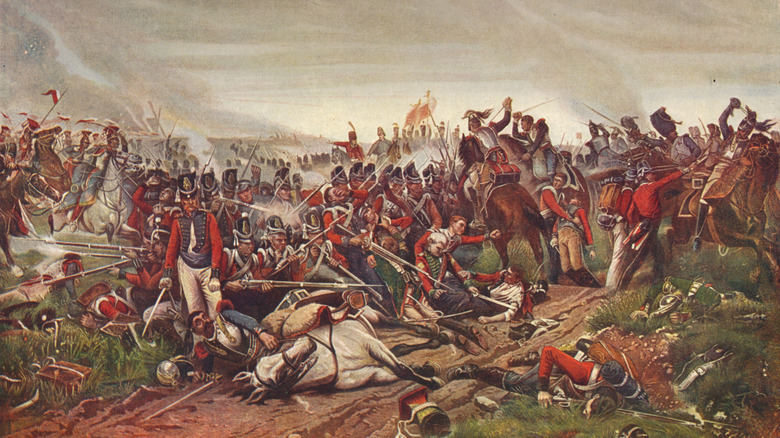What's The Meaning Behind Trooping The Colour?
For more than 260 years, a grand spectacle has taken place in London, England, involving more than 1,400 British troops with hundreds of musicians, horses, and other martial pageantry to celebrate the reigning British monarch's birthday. It's called Trooping the Colour (aka the King's Birthday Parade) and it's just one of the strange British royal rituals that are still carried out today. Another revolves around the fact that King Charles III's birthday is officially celebrated — like that of previous monarchs — in a different month than he was actually born in. His birthday is in November, but with the tempestuous British weather and tradition dating back to the early 1900s, June is the month when this lavish birthday parade now takes place.
The term "Trooping the Colour" harks back to a time before modern communication on the battlefield when soldiers needed a rallying point to keep from getting separated from their regiment. Each regiment had, and still has, its own flag, called a colour, featuring the same single color as the regimental uniform collar, lapels, and cuffs. At the flag's center lies the regimental insignia. In order to hammer home what the regimental Colour looked like to the soldiers, officers would march between the lines of troops with the colour held aloft, which gave rise to the term "trooping."
The colour was a way to rally the troops
For hundreds of years, regimental colours played two important roles. On smoke-filled battlefields where chaos reigned, the colour, held high by the colour guard — the officers who controlled and protected the flag — acted as a rallying point to help keep the troops together, a vital need before radios and other communication devices had been invented. The second role the colours provided was to instill a sense of pride and camaraderie in their regiments. The colours often included the names of important battles the regiment had participated in and were a source of pride.
Many soldiers had a deep relationship with this special flag. In some cases, it was the last thing they saw before death. For instance, as Lieutenant-Colonel William Miller of the 1st Regiment of Foot Guards lay dying following a battle in 1815 during the Napoleonic Wars, one of the deadliest wars in history, he asked his fellow soldiers to bring the colour over. "I should like to see the colours of the Regiment before I quit them for ever," he said (via the National Army Museum). And Trooping the Colour was how the British Army helped instill the flag's sense of importance in its soldiers. At the turn of the 19th century, as warfare changed due to modern, long-range weapons, regimental colours were no longer used in battle since they would easily give away troop movements. Instead, they took on more of a symbolic role.
Trooping the Colour today
The modern Trooping the Colour has its genesis in the 17th century, during the reign of King Charles II who ruled from 1660 to 1685, but it wasn't tied to the birthday celebration of the reigning monarch until 1748. After King George III (yes, the King George who ruled during the American Revolution) ascended the throne in 1760, Trooping the Colour became a (mostly) annual event. It was King Edward VII, who reigned from 1901 to 1910, who began the custom of holding the Trooping the Colour in June (even though his birthday was in November) because he felt the weather would be better.
On June 14, 2025, the King's Birthday Parade will begin and end at Buckingham Palace after proceeding down a royal roadway called the Mall to Horse Guards Parade, an 18th-century building near St. James Park. At Horse Guards Parade, King Charles III's personal troops, from what's called the Household Division, made up of some of the oldest regiments in the British Army — including those who famously wear the red and black uniforms and tall bearskin hats — greet the king with a 41-gun salute. The ceremony includes an inspection by Charles III, bands, and of course the official Trooping. The regimental Colour is marched through the ranks of soldiers, just like it's been done since regimental Colours rallied generations of British troops in battle throughout history.


